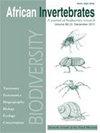远翅蝉属,1912(半翅目,蝉科):系统发育地位和保护状况
IF 1.1
4区 农林科学
Q3 ENTOMOLOGY
引用次数: 0
摘要
蝉属Tugelana Distant, 1912是非洲东南部的单型和特有种。由于没有材料可用于其部落最近的分子系统发育,因此其精确的系统发育位置尚未确定。利用BOLD鉴定系统和NCBI Genbank的BLAST,获得了细胞色素氧化酶基因的627 bp序列,并鉴定了其候选亲缘关系为Platypleura Amyot & Audinet-Serville, 1843的几个物种。贝叶斯推断表明,模式种Maputaland Orangewing Cicada Tugelana butleri Distant, 1912与沙丘Koko Orangewing Cicada Platypleura zuluensis Villet, 1989有密切的亲缘关系,后者的地理分布与T. butleri相似,并且其生殖器官为Platypleura的一个成员。这对物种被放置在非洲厚胸科分支的较深处。因此,我们正式承认Platypleura Amyot & Audinet-Serville, 1843作为Tugelana Distant, 1912, syn11 .的高级同义词,并将T. butleri Distant, 1912分配给Platypleura,作为Platypleura butleri (Distant 1912), comb。11 .该物种生活在马普塔兰海岸高原林荫繁茂的草原上,位于勒邦博山脉以东和马普托湾以南。它的发生范围约为6360平方公里,根据世界自然保护联盟的分类标准,这将使它成为脆弱的保护状态。本文章由计算机程序翻译,如有差异,请以英文原文为准。
The cicada genus Tugelana Distant, 1912 (Hemiptera, Cicadidae): phylogenetic position and conservation status
The cicada genus Tugelana Distant, 1912 is monotypic and endemic to south-eastern Africa. Material was not available for a recent molecular phylogeny of its tribe, so its precise phylogenetic placement is unestablished. Consequently, a 627 bp sequence of the cytochrome oxidase gene was obtained and its candidate relatives identified as several species of Platypleura Amyot & Audinet-Serville, 1843 using the BOLD Identification System and NCBI Genbank’s BLAST. Bayesian inference analyses indicated that the type species, the Maputaland Orangewing Cicada Tugelana butleri Distant, 1912, is closely related to the Dune Koko Orangewing Cicada Platypleura zuluensis Villet, 1989, which has a geographical distribution that is parapatric with T. butleri and which has aberrant genitalia for a member of Platypleura. This pair of species is placed fairly deep within the African clade of Platypleura. We therefore formally recognized Platypleura Amyot & Audinet-Serville, 1843 as a senior synonym of Tugelana Distant, 1912, syn. nov., and assign T. butleri Distant, 1912 to Platypleura as Platypleura butleri (Distant 1912), comb. nov. The species occurs on the wooded grasslands of the Maputaland coastal plateau east of Lebombo Mountains and south of Maputo Bay. Its Extent of Occurrence is about 6360 km2, which would qualify it as Vulnerable under the IUCN’s classification criteria for conservation status.
求助全文
通过发布文献求助,成功后即可免费获取论文全文。
去求助
来源期刊

African Invertebrates
生物-动物学
CiteScore
1.00
自引率
0.00%
发文量
6
审稿时长
>12 weeks
期刊介绍:
African Invertebrates is an international peer-reviewed, open-access journal that focuses primarily on the taxonomy, systematics, biogeography, and palaeontology of Afrotropical invertebrates, whether terrestrial, freshwater or marine. Aspects concerning biology, ecology, and conservation may also be considered where these relate to the primary focus areas. Papers dealing solely with biology, ecology, physiology, pests and pest control should be submitted elsewhere.
 求助内容:
求助内容: 应助结果提醒方式:
应助结果提醒方式:


